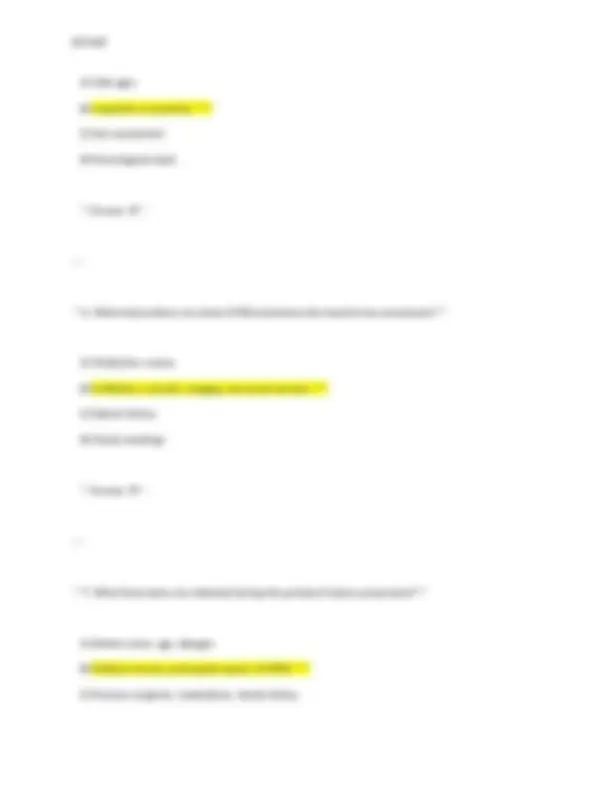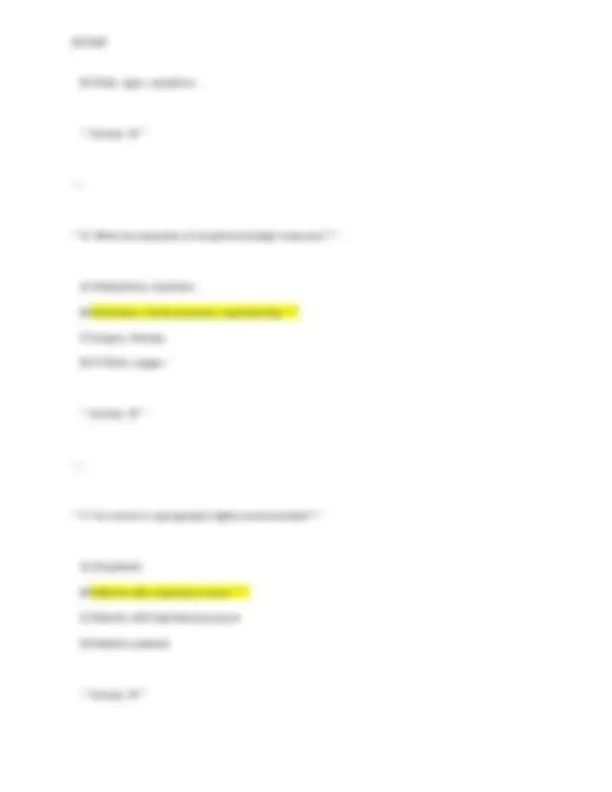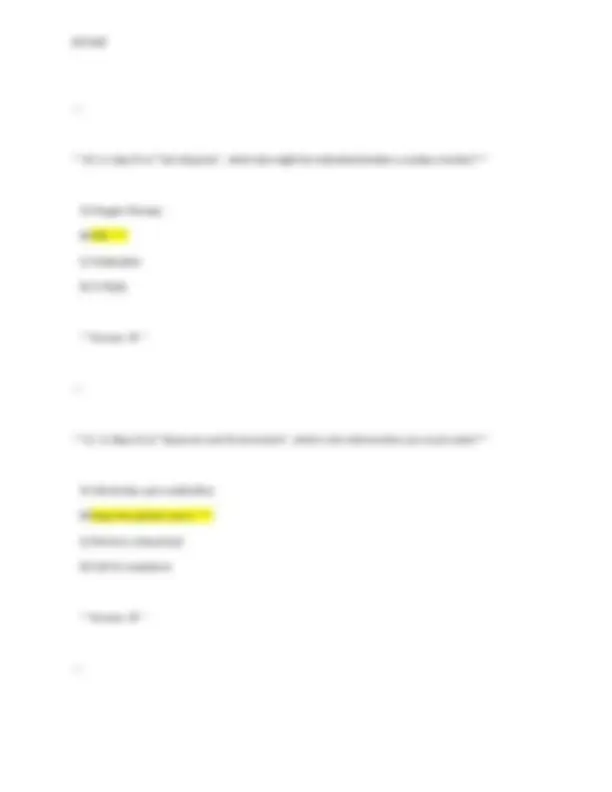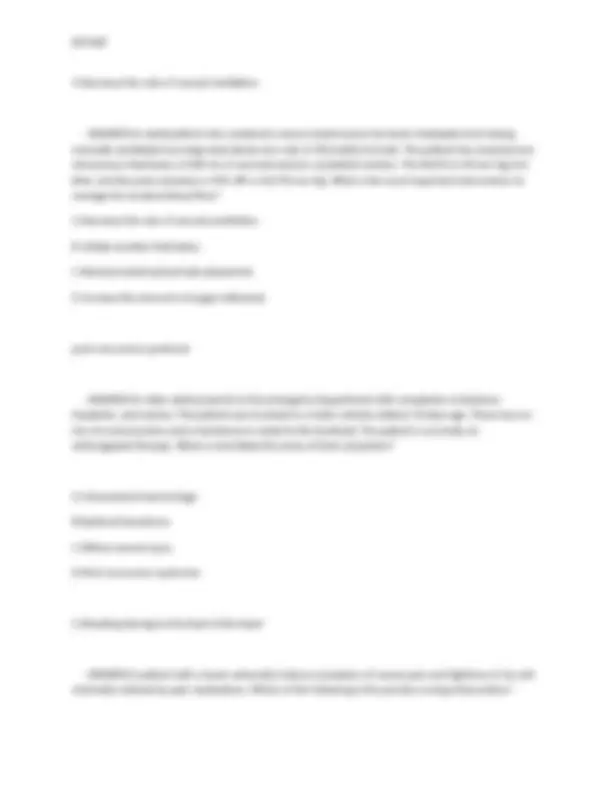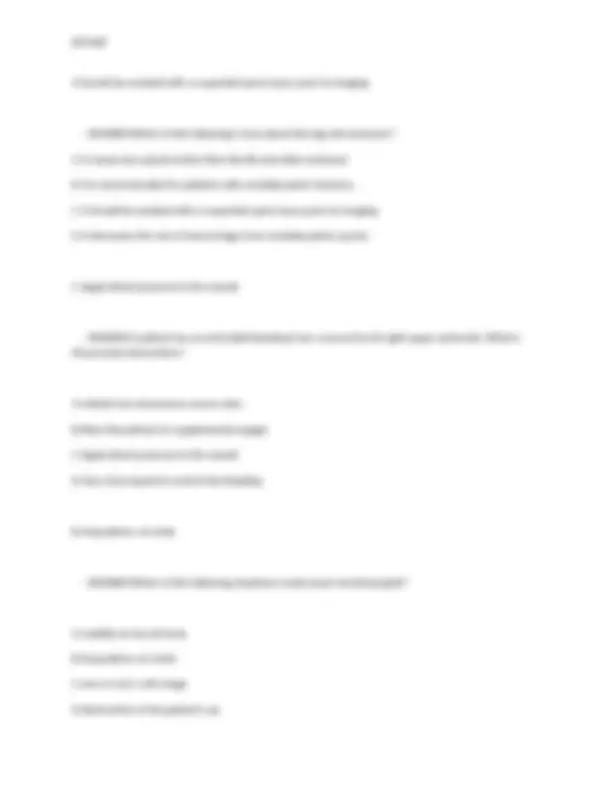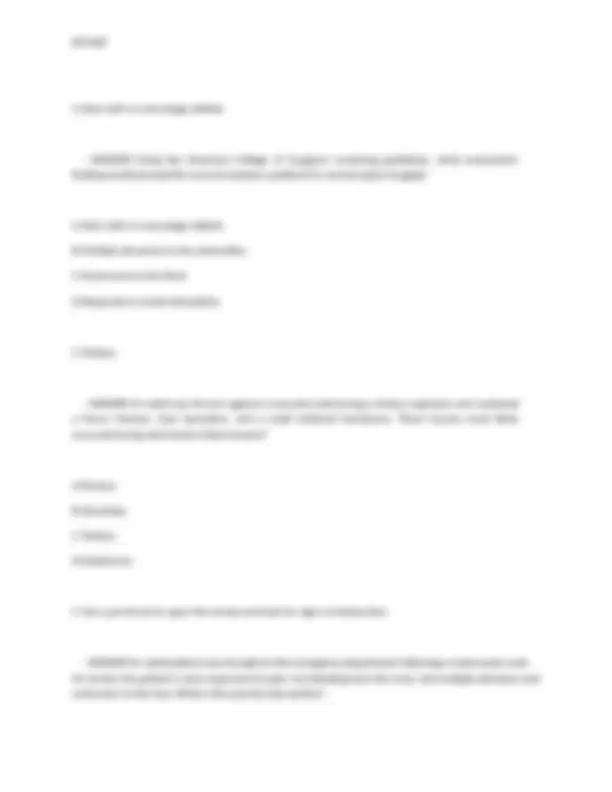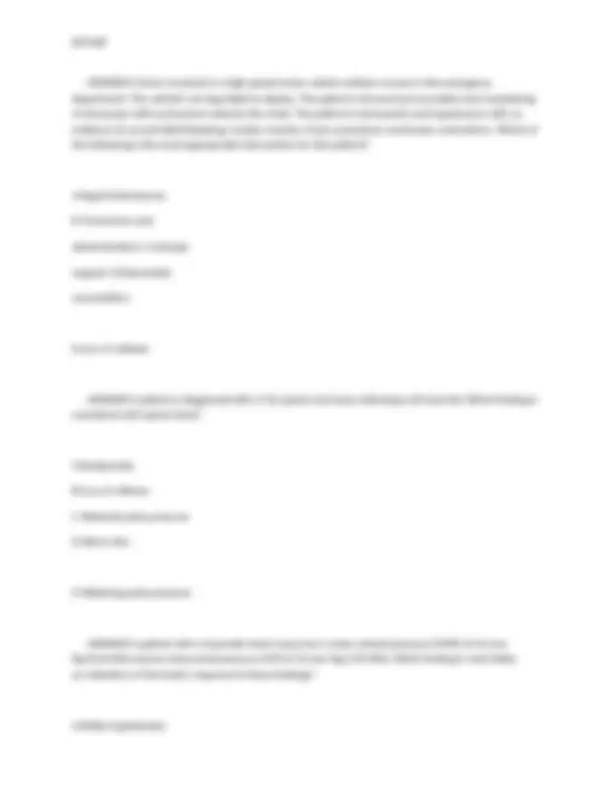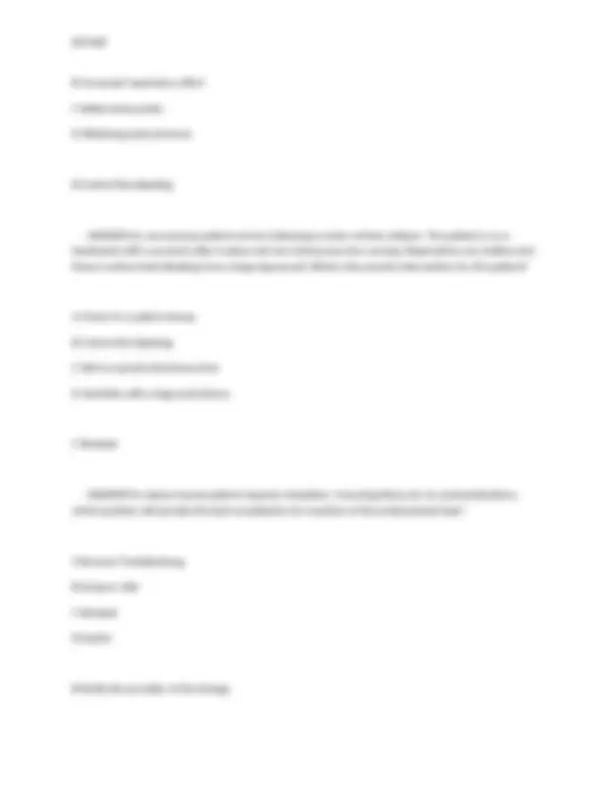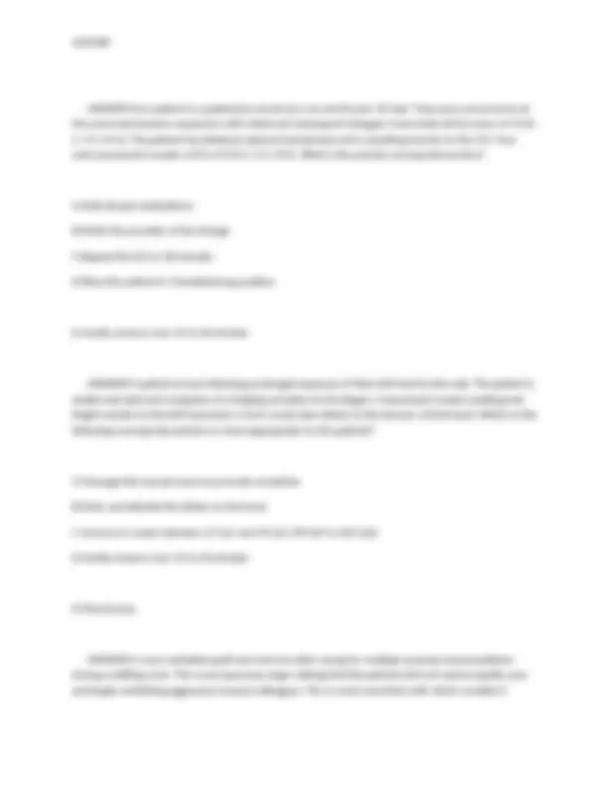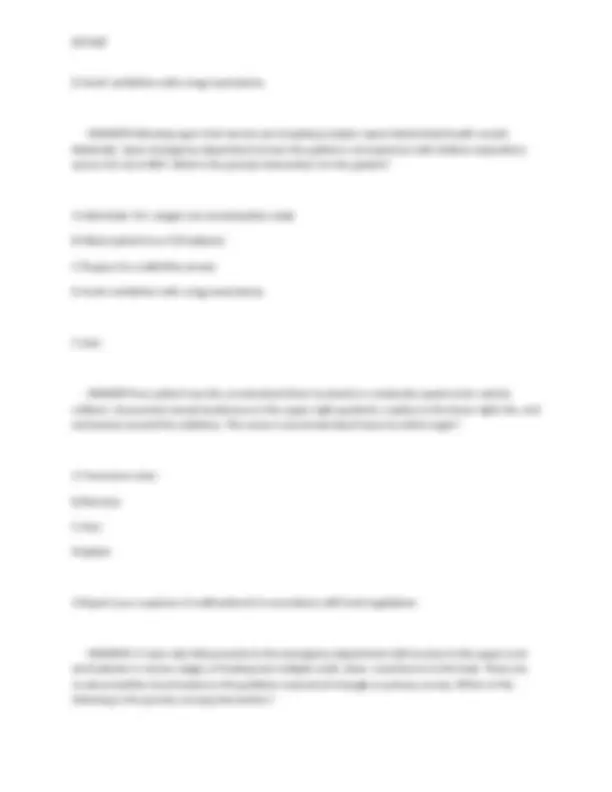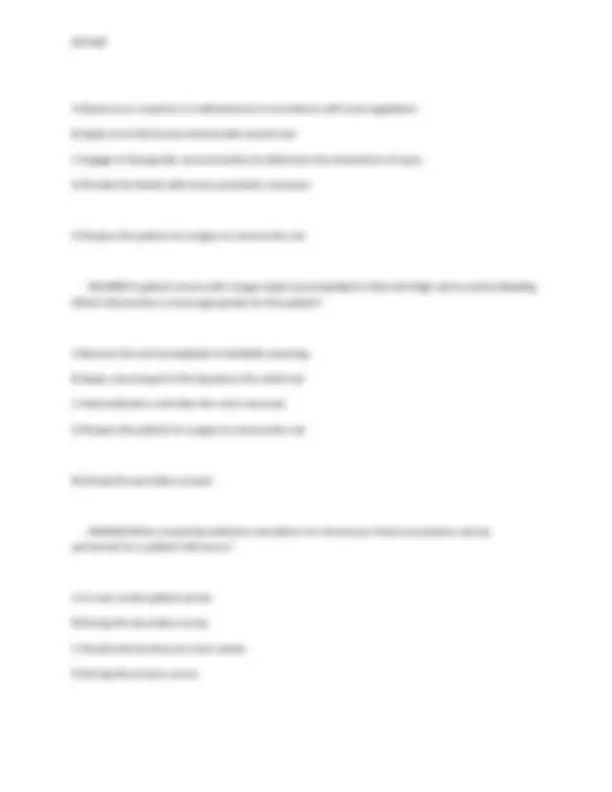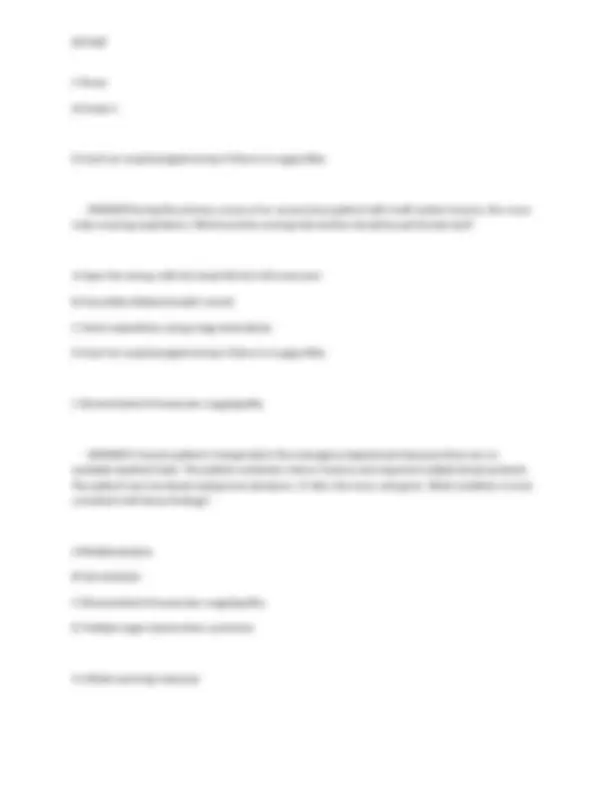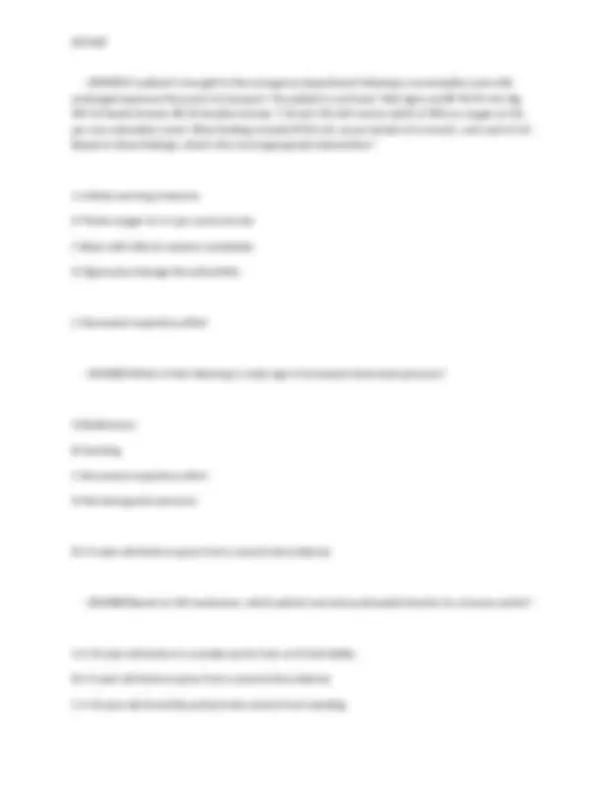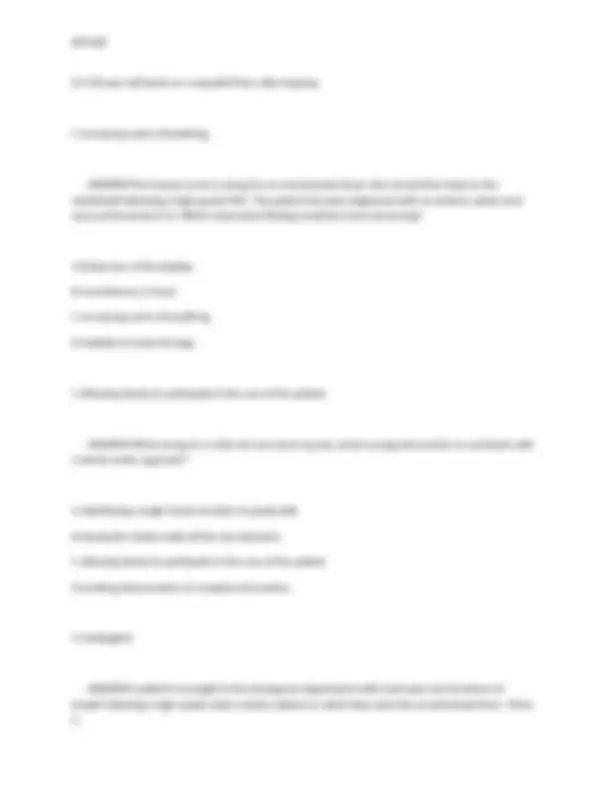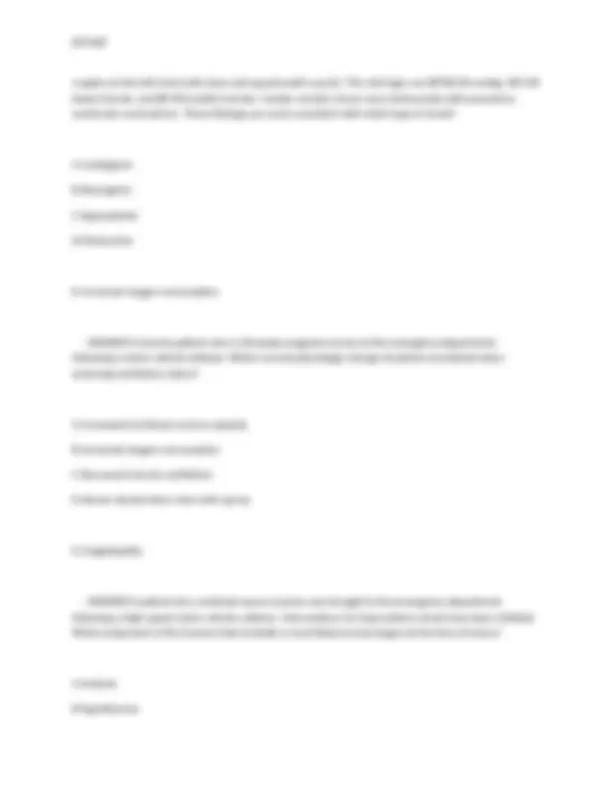Download TNCC 9TH EDITION TNP CORRECT ANSWERSALL ANSWERED 100% and more Exams Nursing in PDF only on Docsity!
TNCC 9TH EDITION TNP CORRECT ANSWERSALL
ANSWERED 100%
1. What does the "J" stand for at the end of the secondary survey? A) Joints B) Judgment C) Justification D) Just check *** Answer: D
2. What does VIPP stand for in trauma assessment? A) Vital signs, Injuries/Interventions, Primary survey, Pain *** B) Vital signs, Intensity, Previous history, Pain C) Vitals, Interventions, Procedures, Pain D) Vitals, Injuries, Protocols, Procedures Answer: A
3. Where would you find Grey-Turner's sign during a head-to-toe assessment? A) Neck B) Flank *** C) Abdomen D) Groin Answer: B
4. Where would you find Cullen's sign during a head-to-toe assessment? A) Chest B) Arm C) Umbilicus *** D) Leg Answer: C
5. What is sometimes deferred at the end of the head-to-toe assessment?
D) Vitals, signs, symptoms Answer: B
8. What are examples of nonpharmacologic measures? A) Medications, injections B) Distraction, family presence, repositioning *** C) Surgery, therapy D) IV fluids, oxygen Answer: B
9. For whom is capnography highly recommended? A) All patients B) Patients with respiratory issues *** C) Patients with high blood pressure D) Pediatric patients Answer: B
10. In step M of "Get Adjuncts", what else might be indicated besides a cardiac monitor? A) Oxygen therapy B) EKG *** C) Medication D) IV fluids Answer: B
11. In Step 16 of "Exposure and Environment", what is one intervention you must name? A) Administer pain medication B) Keep the patient warm *** C) Perform a blood test D) Call for assistance Answer: B
B) Inspect breathing and assess skin color C) Check pulse and blood pressure *** D) Evaluate mobility and response time Answer: C
15. What do you do when alterations are identified in any of the steps in the primary survey? A) Call for help B) Intervene as appropriate and reassess *** C) Document the findings D) Move to the next step Answer: B
16. What three assessments must be done if the patient is intubated? A) Blood pressure, pulse, temperature B) Breath sounds, chest rise, oxygen saturation *** C) Reflexes, strength, responsiveness D) Skin color, capillary refill, temperature
Answer: B
17. What four indicators must be identified to assess breathing effectiveness? A) Pulse, blood pressure, skin color, temperature B) Breath sounds, chest rise, work of breathing, and skin color *** C) Heart rate, capillary refill, mental status, and temperature D) Blood pressure, respiratory rate, mental status, and pulse Answer: B cardiac monitor
- ANSWER What can be applied in step 12 of "Circulation and Control of Hemorrhage" for which credit is given in the LMNOP section? During "Circulation" assessment
- ANSWER When should 2 IV sites be established? assess ETT position by noting the number at teeth/gums AND secure ETT
A.Decrease the rate of manual ventilation.
- ANSWER An adult patient who sustained a severe head trauma has been intubated and is being manually ventilated via a bag-mask device at a rate of 18 breaths/minute. The patient has received one intravenous fluid bolus of 500 mL of warmed isotonic crystalloid solution. The PaCO2 is 30 mm Hg (4. kPa), and the pulse oximetry is 92%. BP is 142/70 mm Hg. What is the most important intervention to manage the cerebral blood flow? A.Decrease the rate of manual ventilation. B.Initiate another fluid bolus. C.Recheck endotracheal tube placement. D.Increase the amount of oxygen delivered. post-concussive syndrome
- ANSWER An older adult presents to the emergency department with complaints of dizziness, headache, and nausea. The patient was involved in a motor vehicle collision 10 days ago. There was no loss of consciousness and a hematoma is noted to the forehead. The patient is currently on anticoagulant therapy. What is most likely the cause of their symptoms? A.Intracerebral hemorrhage B.Epidural hematoma C.Diffuse axonal injury D.Post-concussive syndrome C.Elevating the leg to the level of the heart
- ANSWER A patient with a lower extremity fracture complains of severe pain and tightness in his calf, minimally relieved by pain medications. Which of the following is the priority nursing intervention?
A.Elevating the leg above the level of the heart B.Repositioning the leg and applying ice C.Elevating the leg to the level of the heart D.Preparing the patient for ultrasound of the leg Bowel sounds heard in the left lower chest
- ANSWER A patient involved in a high-speed rollover is complaining of increased difficulty breathing. There is a small penetrating wound to the sixth intercostal space in the left lateral chest. Which finding is most consistent with an injury to the diaphragm? A.Severe left-sided abdominal pain B.Bowel sounds heard in the left lower chest C.Pain radiating to the left shoulder. D.Decreased breath sounds on the left side fat embolism
- ANSWER A patient has been in the emergency department for several hours waiting to be admitted. They sustained multiple rib fractures and a femur fracture after a fall. The patient has been awake, alert, and complaining of leg pain. Their spouse reported that the patient suddenly became anxious and confused. Upon reassessment, the patient is restless, with respiratory distress and petechiae to his neck. The patient is exhibiting signs and symptoms most commonly associated with which of the following conditions? A.Acute lung injury B.Fat embolism
- ANSWER A patient has been diagnosed with an incomplete spinal cord injury at L1. Which finding would indicate sacral sparing? A.Involuntary flexion of the great toe B.Priapism C.Voluntary anal sphincter tone D.Numbness to the perianal area urinary incontinence
- ANSWER While caring for a trauma patient in the emergency department, what finding raises suspicion of a complete spinal cord injury? A.Weakness in the lower extremities B.Urinary incontinence C.Sacral sparing D.Spastic paralysis of the legs B. Rising diastolic
- ANSWER Which blood pressure finding is associated with early or compensated hypovolemic shock? A.Rising systolic B.Rising diastolic C.Decreasing diastolic D.Decreasing systolic
It should be avoided with a suspected spine injury prior to imaging
- ANSWER Which of the following is true about the log-roll maneuver? A.It causes less spinal motion than the lift-and-slide maneuver B.It is recommended for patients with unstable pelvic fractures C.It should be avoided with a suspected spine injury prior to imaging D.It decreases the risk of hemorrhage from unstable pelvic injuries C.Apply direct pressure to the wound
- ANSWER A patient has uncontrolled bleeding from a wound to his right upper extremity. What is the priority intervention? A.Initiate two intravenous access sites B.Place the patient on supplemental oxygen C.Apply direct pressure to the wound D.Use a tourniquet to control the bleeding B.Amputation of a limb
- ANSWER Which of the following situations could cause functional grief? A.Inability to live at home B.Amputation of a limb C.Loss of one's self-image D.Destruction of the patient's car
A.Use a bulb syringe to suction out secretions from the mouth. B.Insert a nasopharyngeal airway to maintain an open airway. C.Use a jaw thrust to open the airway and look for signs of obstruction. D.Ask the patient to open their mouth to inspect the airway. Apply a pelvic binder
- ANSWER An adult pedestrian was struck on the right side by a sport utility vehicle traveling at 40 mph. The patient is awake and alert and the right leg is shortened. Following initial resuscitation with fluids, the patient remains hypotensive. What would be the priority intervention? A.Send blood for type and crossmatch B.Apply a pelvic binder C.Prepare the patient for surgery D.Insert a urinary catheter C.Decreased body temperature
- ANSWER A severely injured patient has been intubated and is being mechanically ventilated. The patient has received a balanced resuscitation including multiple blood products. Under which circumstance will it be harder for the hemoglobin to release oxygen to the tissues? A.Decreased pH B.Elevated carbon dioxide level C.Decreased body temperature D.Increased metabolic demand
Initiate two large-caliber intravenous lines for isotonic crystalloid administration.
- ANSWER A patient is thrown against a car during a tornado and presents with obvious bilateral femur fractures. The patient is pale, alert, disoriented, and has delayed capillary refill. Which of the following interventions would be most appropriate for this patient based on the disaster triage principles? A.Initiate two large-caliber intravenous lines for isotonic crystalloid administration. B.Administer intravenous medications for pain. C.Place the patient in an observation area for care within the next few hours. D.Contact the command center for personnel to notify next of kin. C.Dressing removal
- ANSWER A patient arrives with a large open chest wound after being assaulted with a machete. Prehospital providers placed a nonporous dressing over the chest wound and taped it on three sides. The patient is now showing signs of anxiety, restlessness, severe respiratory distress, cyanosis, and decreasing blood pressure. Which of the following is the MOST appropriate immediate intervention? A.Needle decompression B.Tube thoracostomy C.Dressing removal D.Surgical repair C.Inotropic support
B.Increased respiratory effort C.Reflex tachycardia D.Widening pulse pressure B.Control the bleeding
- ANSWER An unconscious patient arrives following a motor vehicle collision. The patient is on a backboard with a cervical collar in place and one intravenous line running. Respirations are shallow and there is active brisk bleeding from a large leg wound. What is the priority intervention for this patient? A.Check for a patent airway B.Control the bleeding C.Start a second intravenous line D.Ventilate with a bag-mask device C.Ramped
- ANSWER An obese trauma patient requires intubation. Assuming there are no contraindications, which position will provide the best visualization for insertion of the endotracheal tube? A.Reverse Trendelenburg B.Lying on side C.Ramped D.Supine B.Notify the provider of the change
\ESTUDY
- ANSWER Your patient is a pedestrian struck by a car and thrown 35 feet. They were unconscious at the scene but became responsive with initial and subsequent Glasgow Coma Scale (GCS) scores of 13 (E- 3, V-4, M-6). The patient has bilateral subdural hematomas and is awaiting transfer to the ICU. Your next assessment reveals a GCS of 9 (E-2, V-2, M-5). What is the priority nursing intervention? A.Hold all pain medications B.Notify the provider of the change C.Repeat the GCS in 30 minutes D.Place the patient in Trendelenburg position D.Gently rewarm over 15 to 30 minutes
- ANSWER A patient arrives following prolonged exposure of their left hand to the cold. The patient is awake and alert and complains of a tingling sensation to the fingers. Assessment reveals swelling and bright red skin to the left hand and a 1-inch round clear blister to the dorsum of that hand. Which of the following nursing interventions is most appropriate for this patient? A.Massage the injured areas to promote circulation B.Drain and debride the blister on the hand C.Immerse in water between 37.5oC and 39.5oC (99.5oF to 103.1oF). D.Gently rewarm over 15 to 30 minutes D.Moral injury
- ANSWER A nurse verbalizes guilt and remorse after caring for multiple severely injured patients during a staffing crisis. The nurse expresses anger stating that the patients did not receive quality care and begins exhibiting aggression toward colleagues. This is most consistent with which condition?

